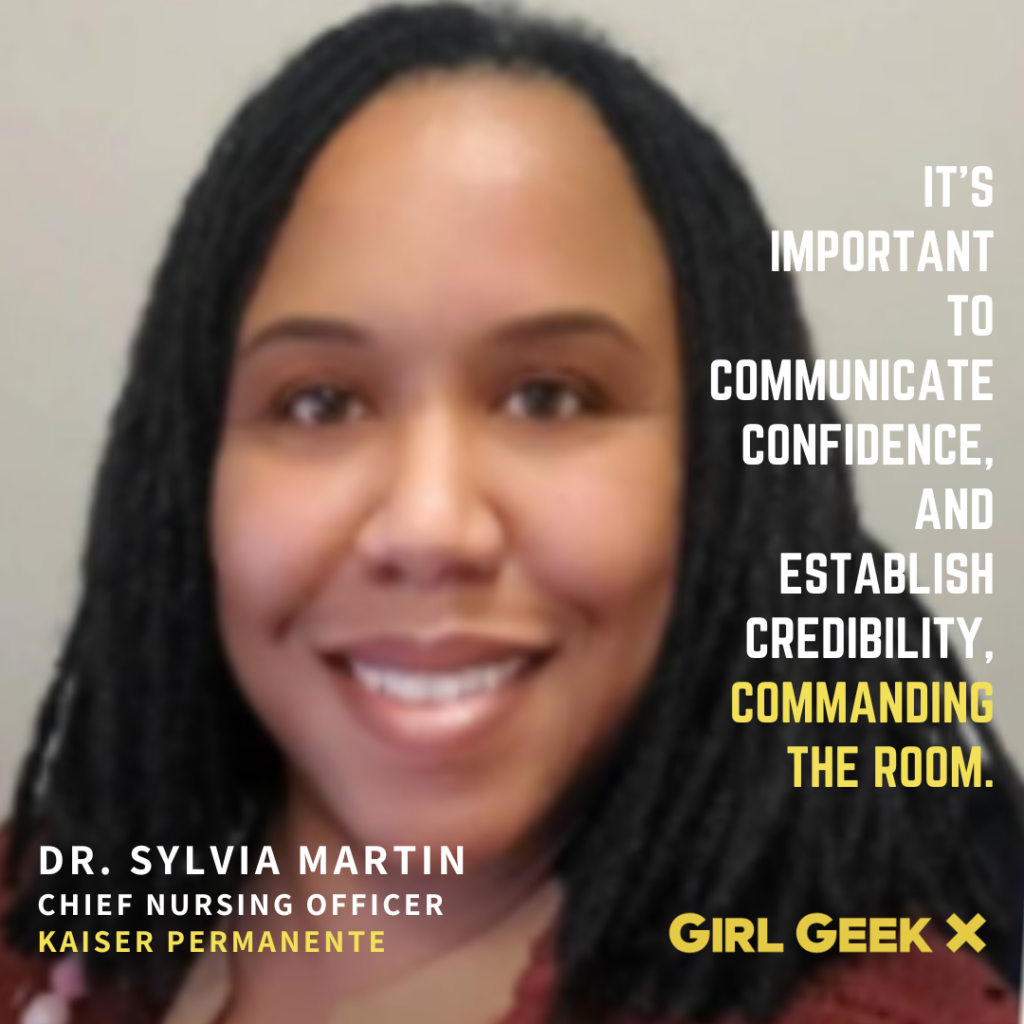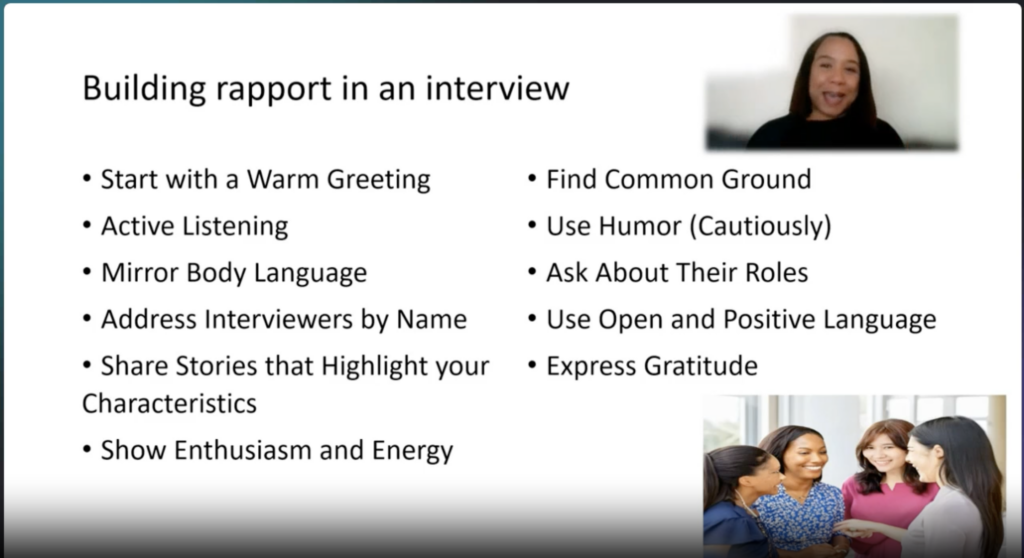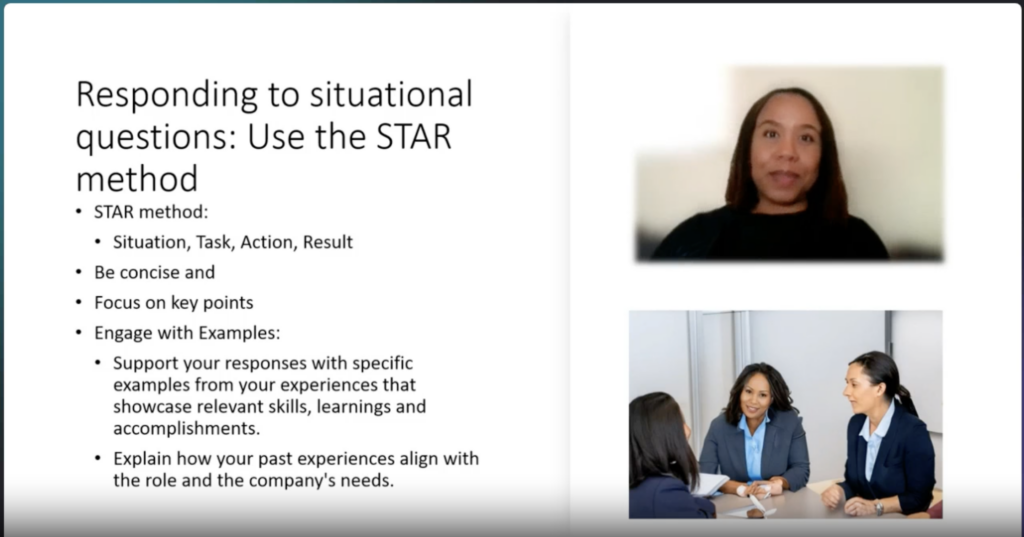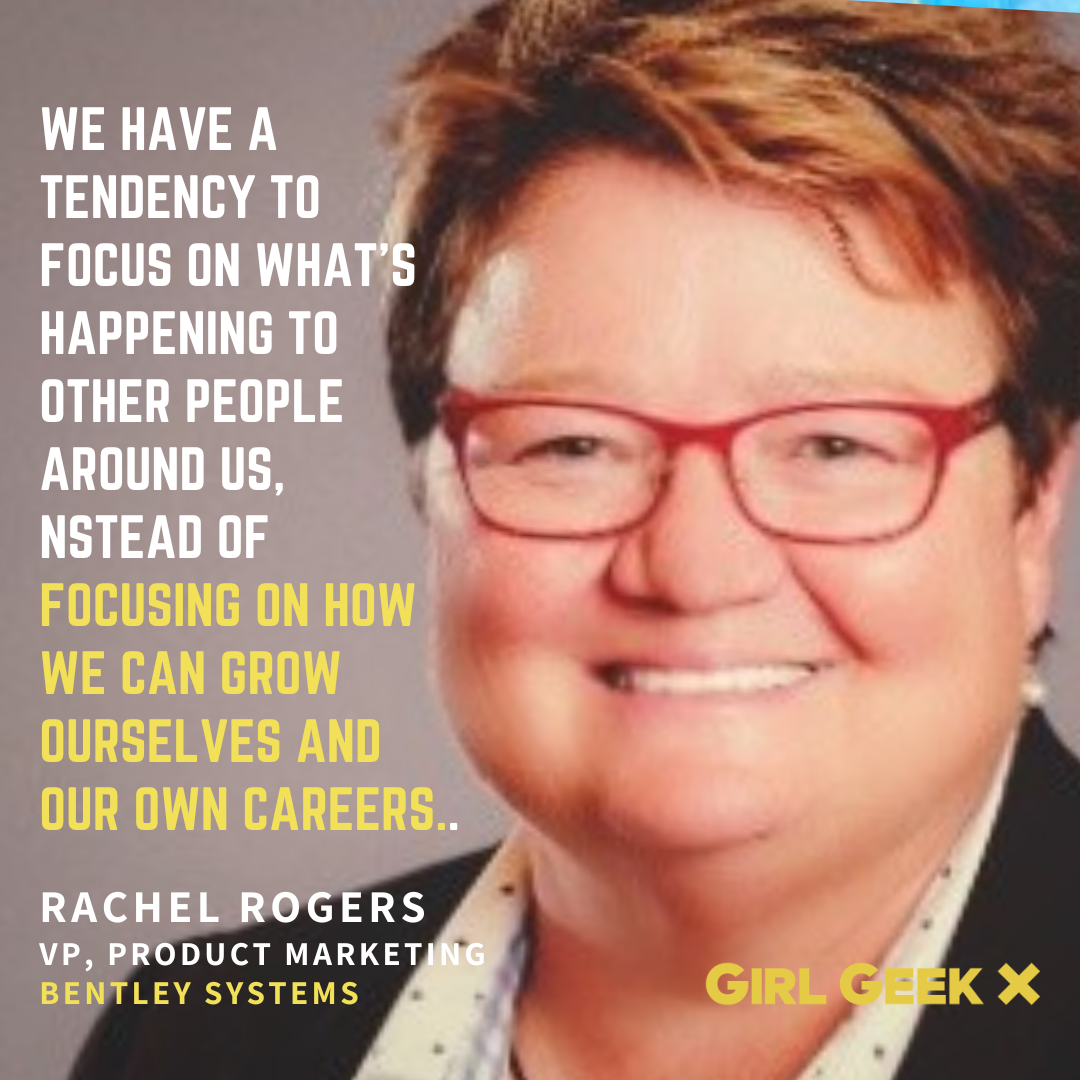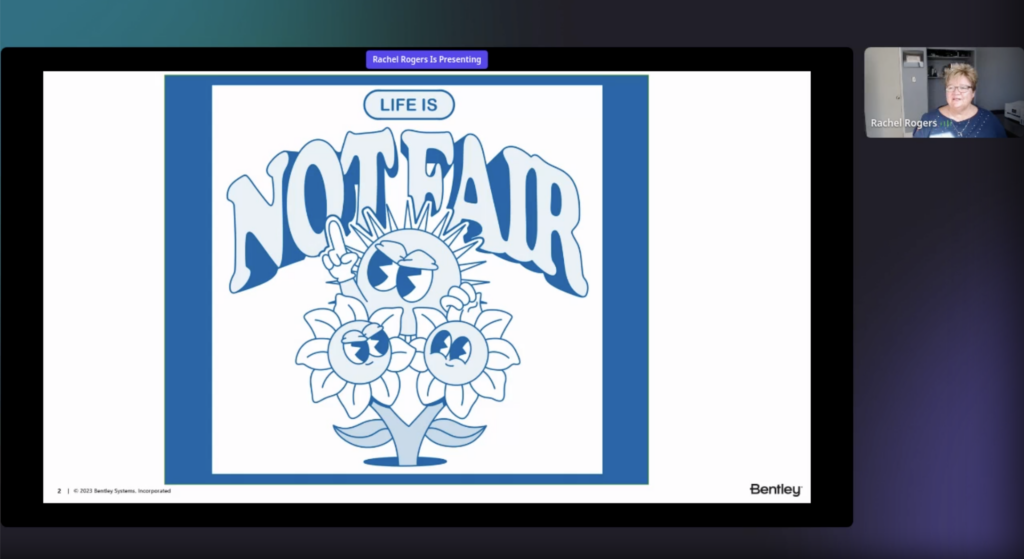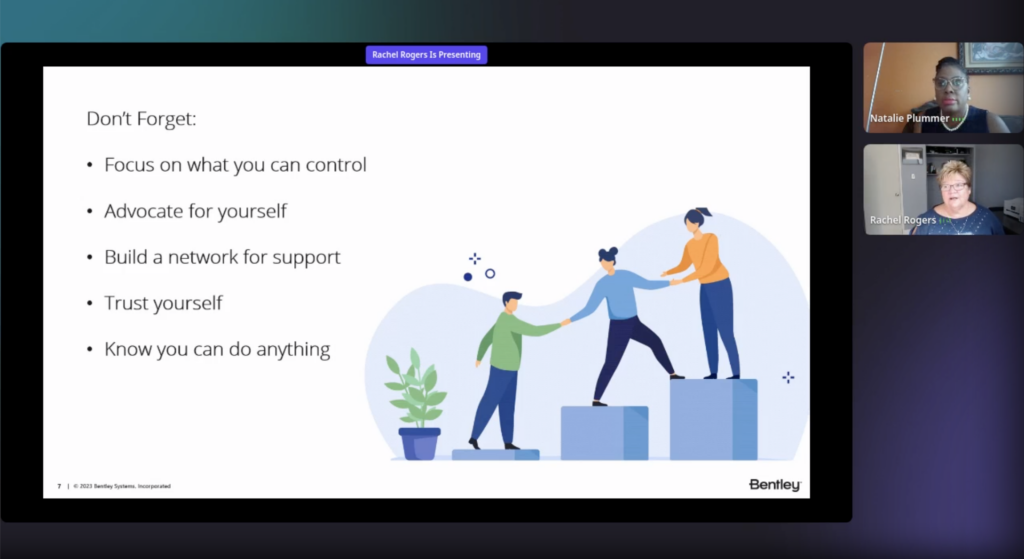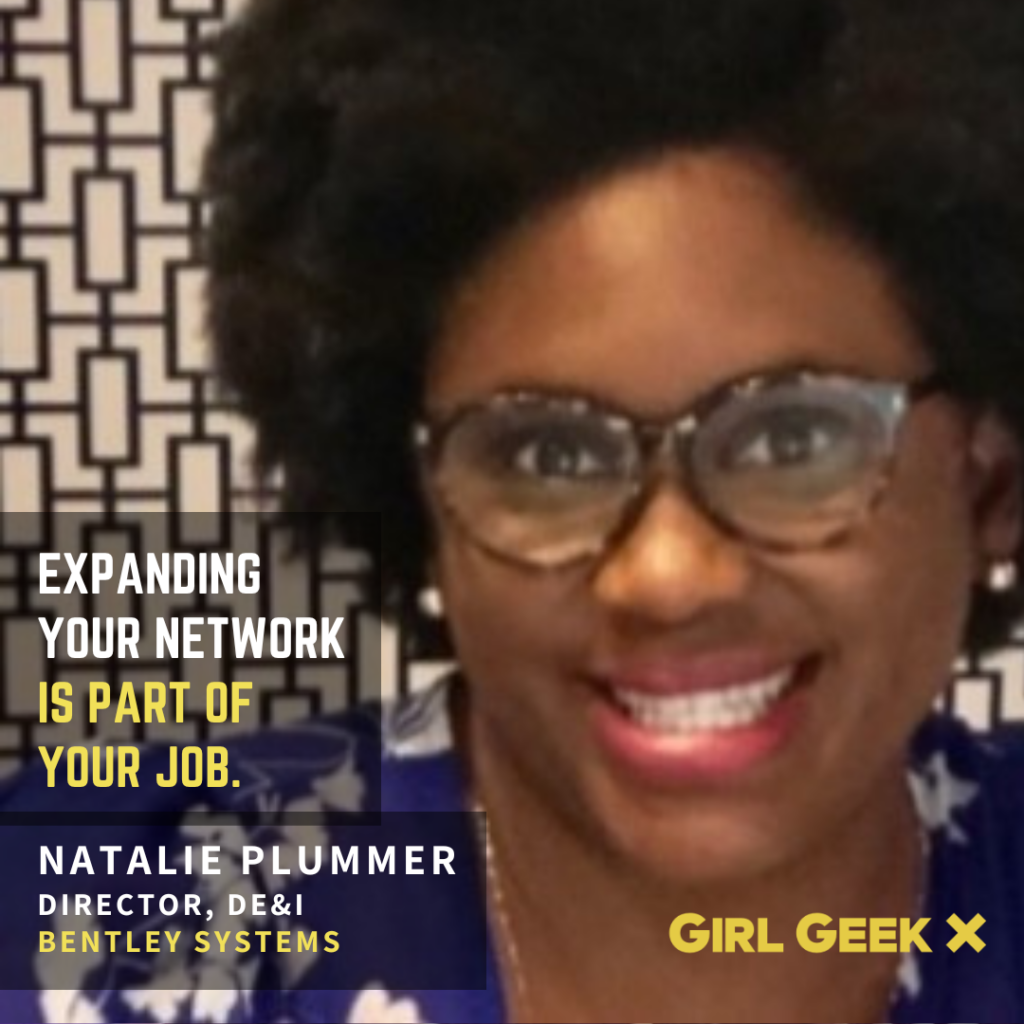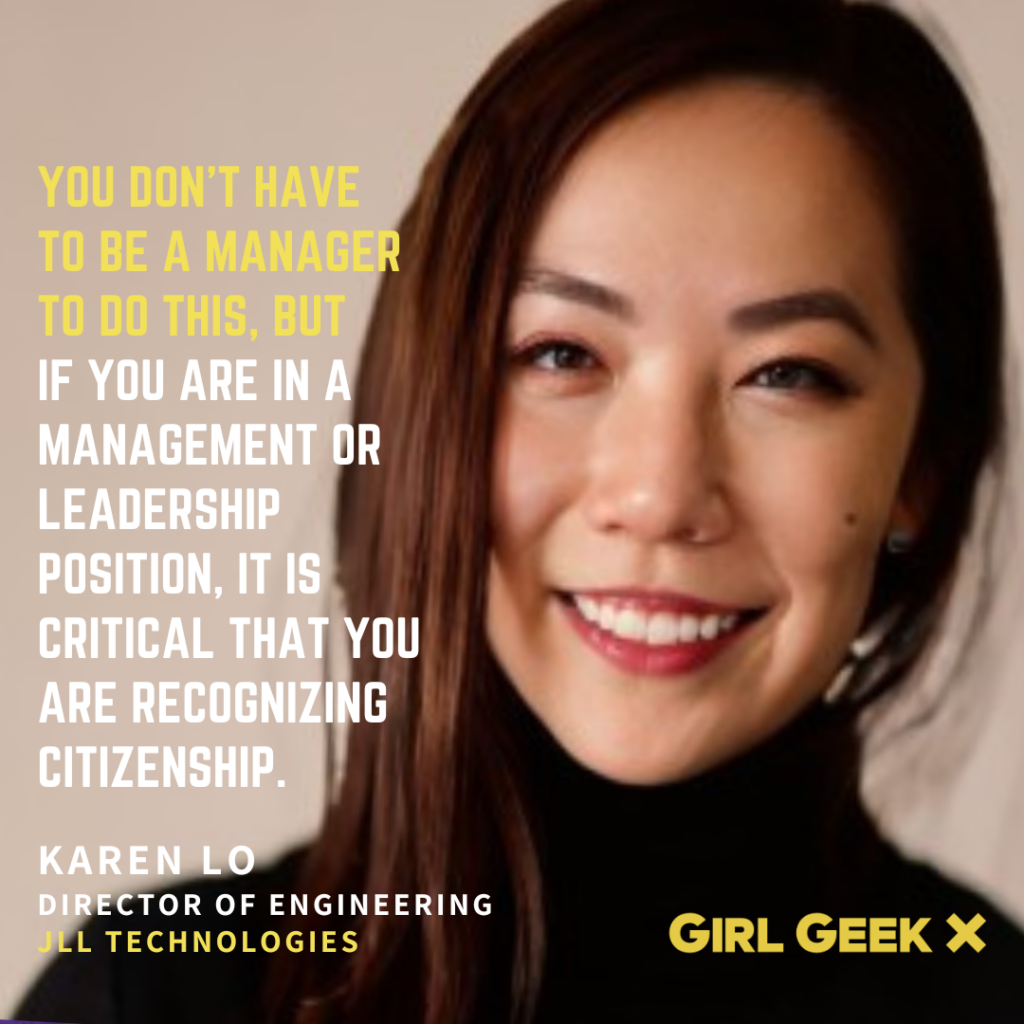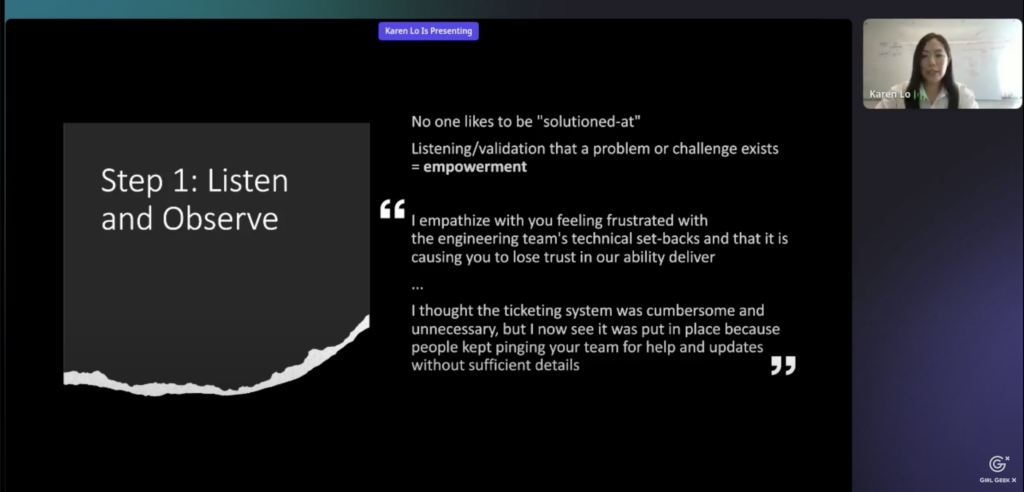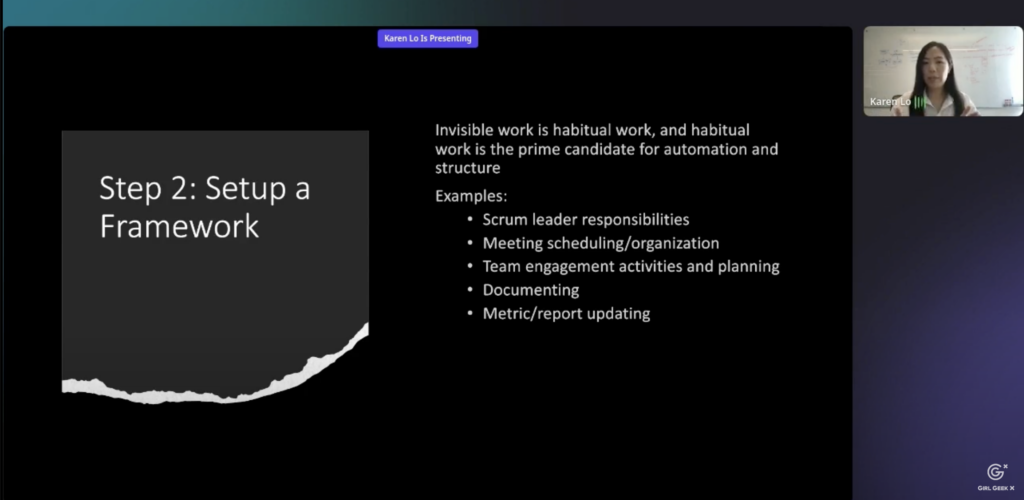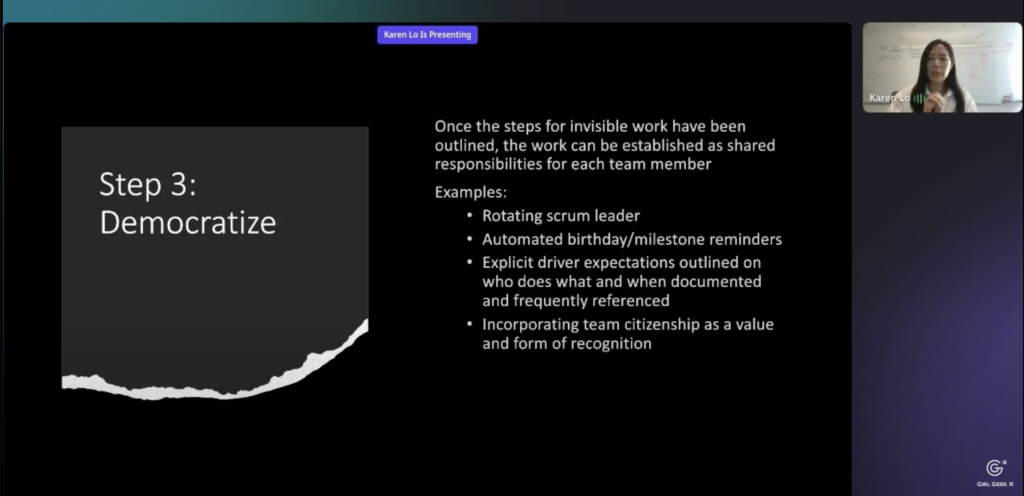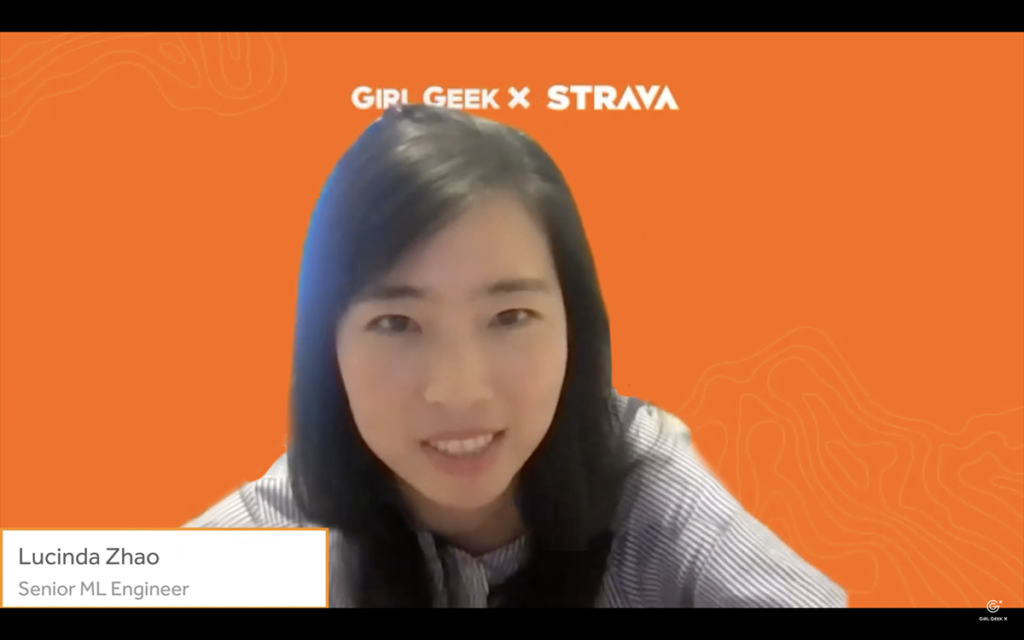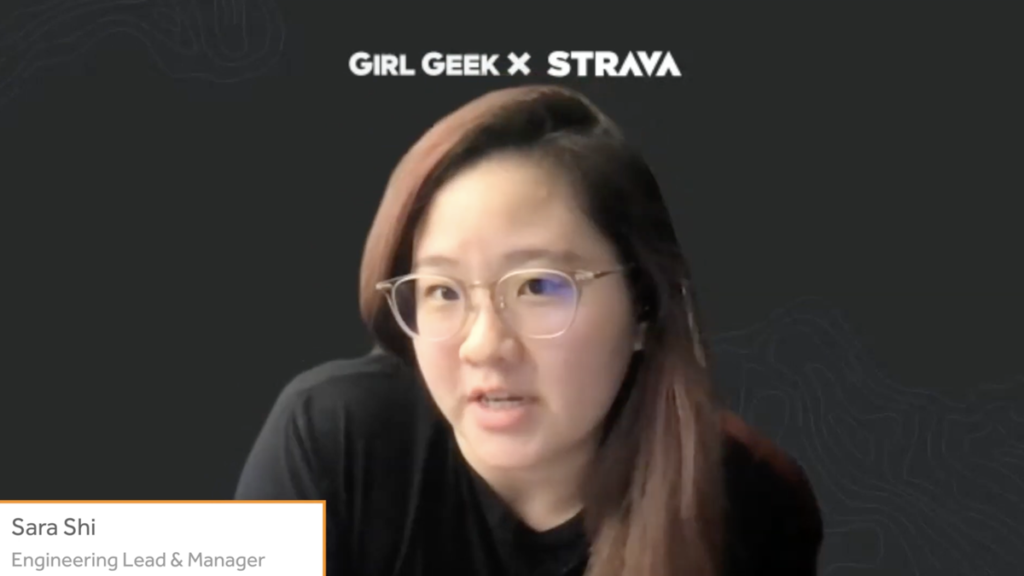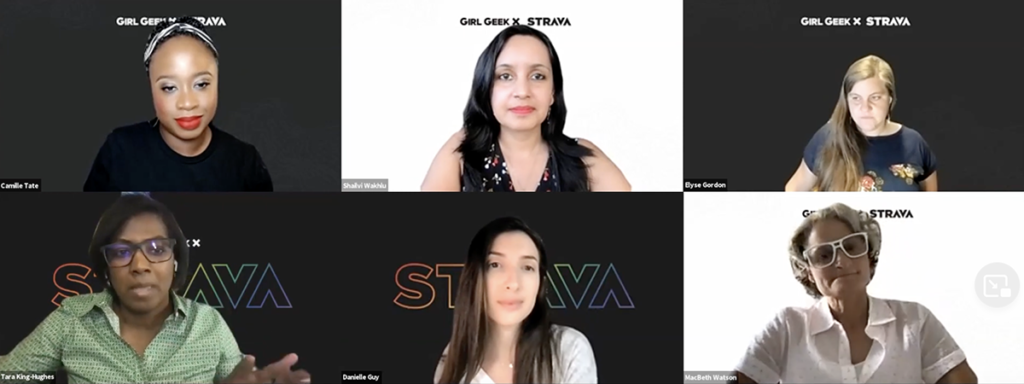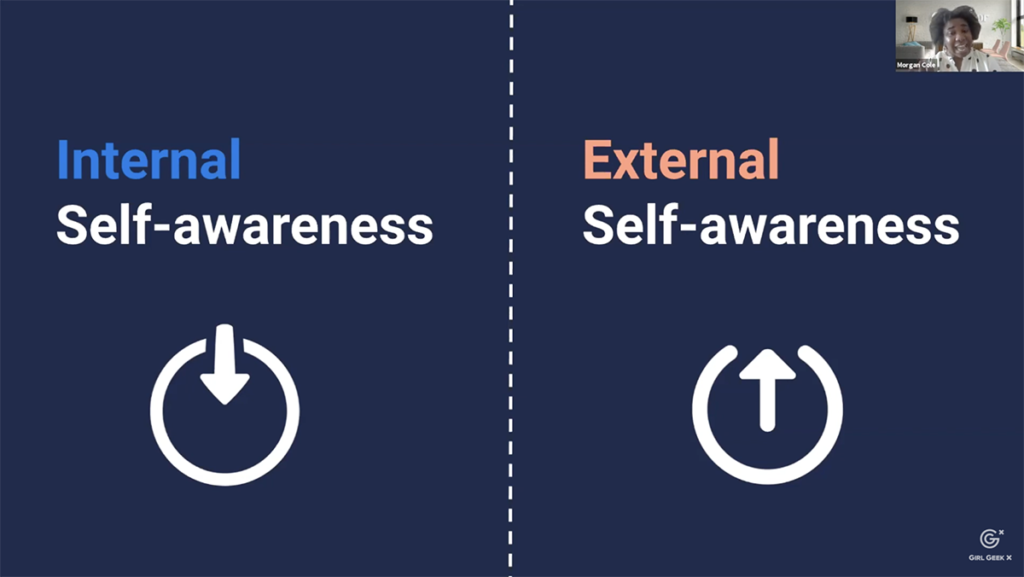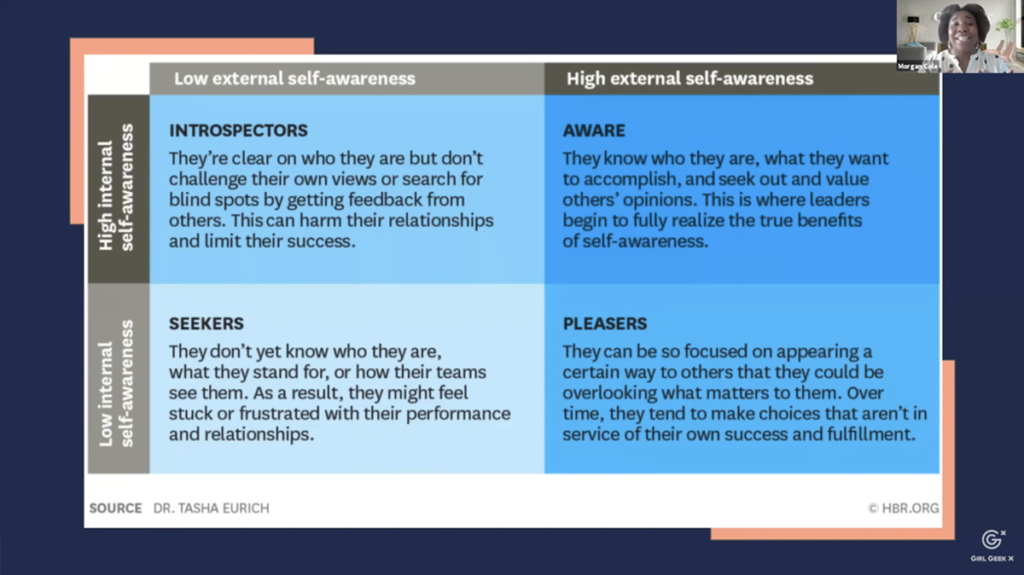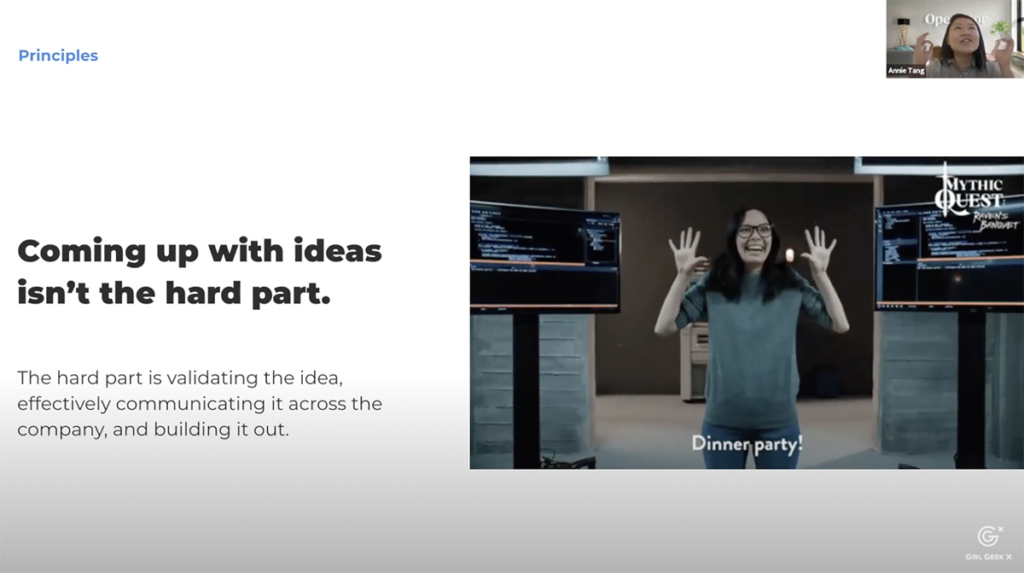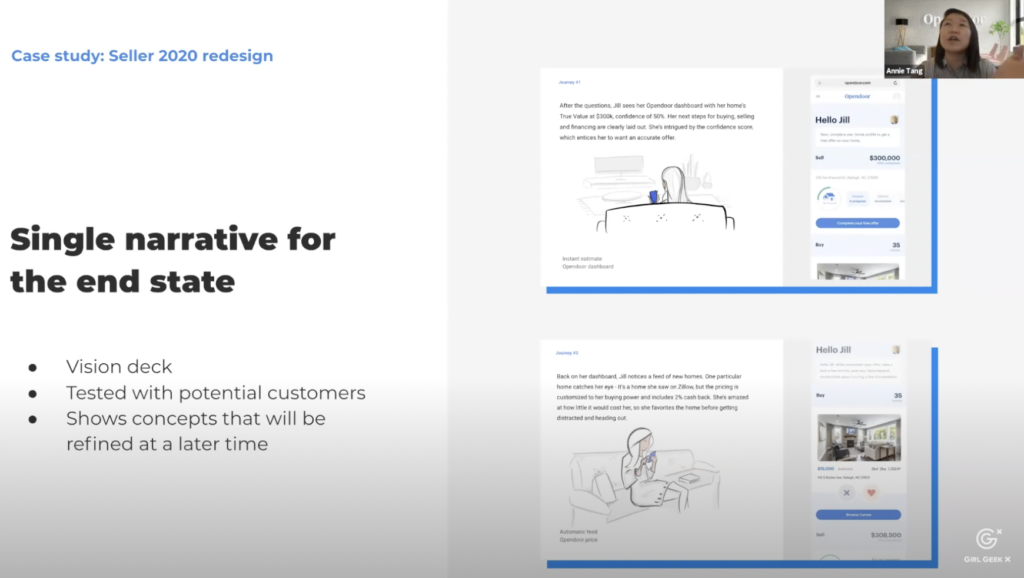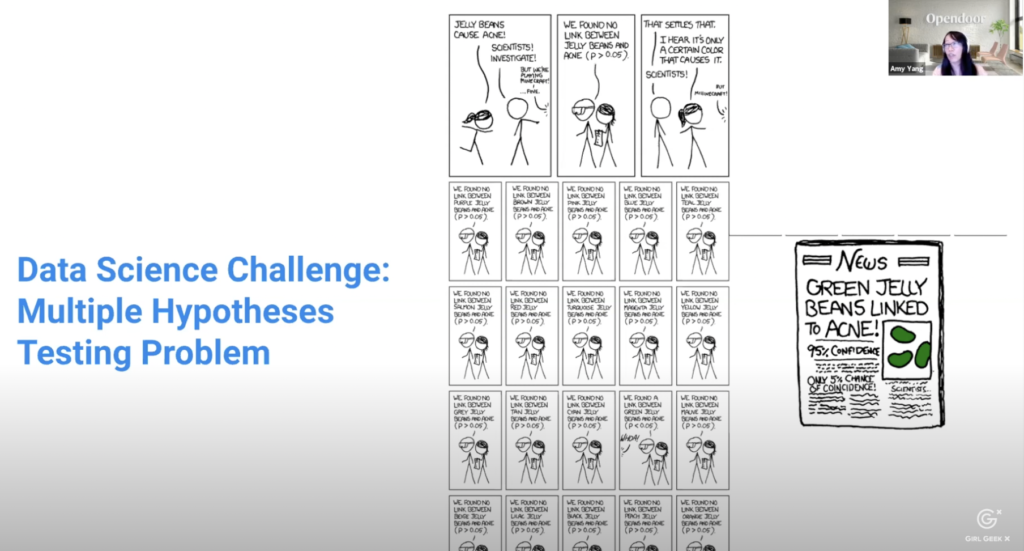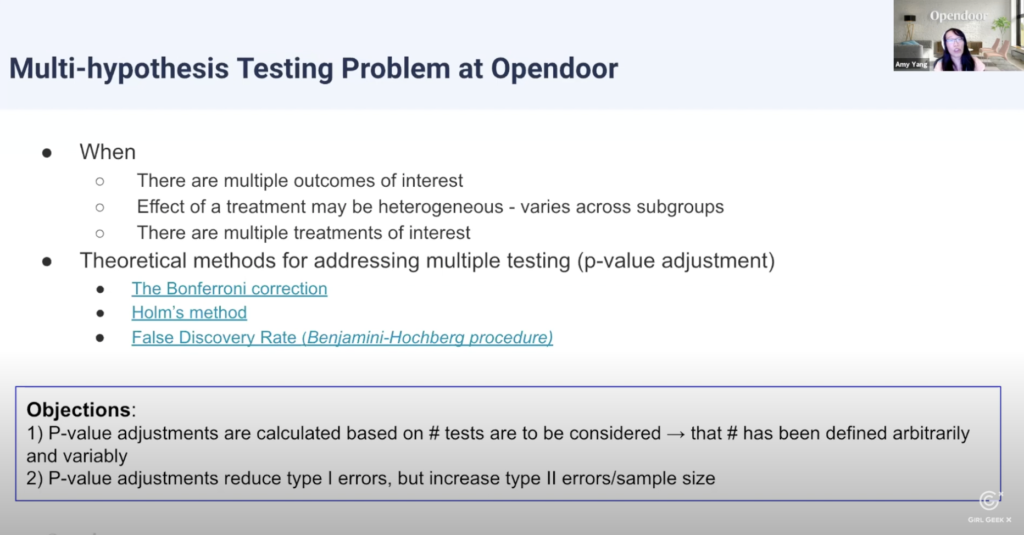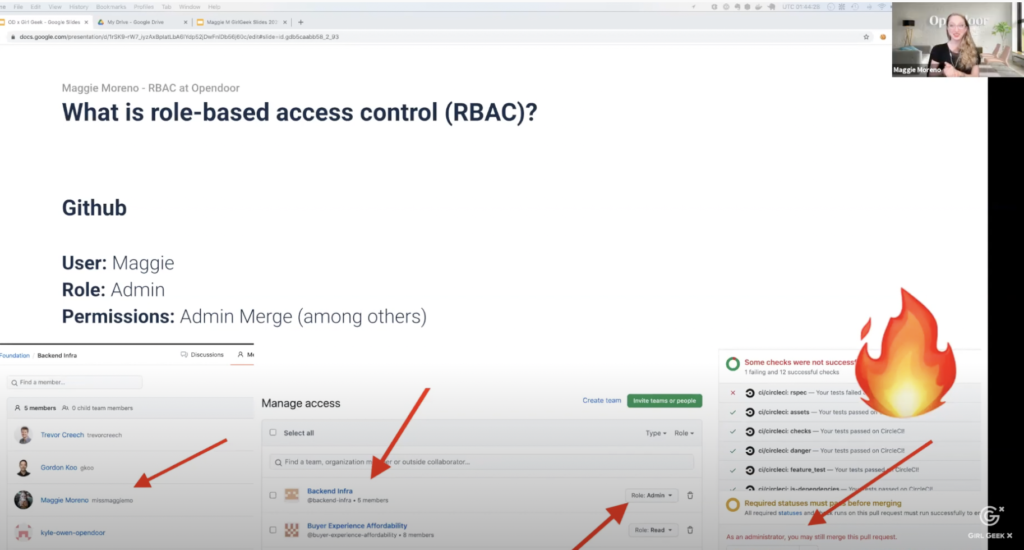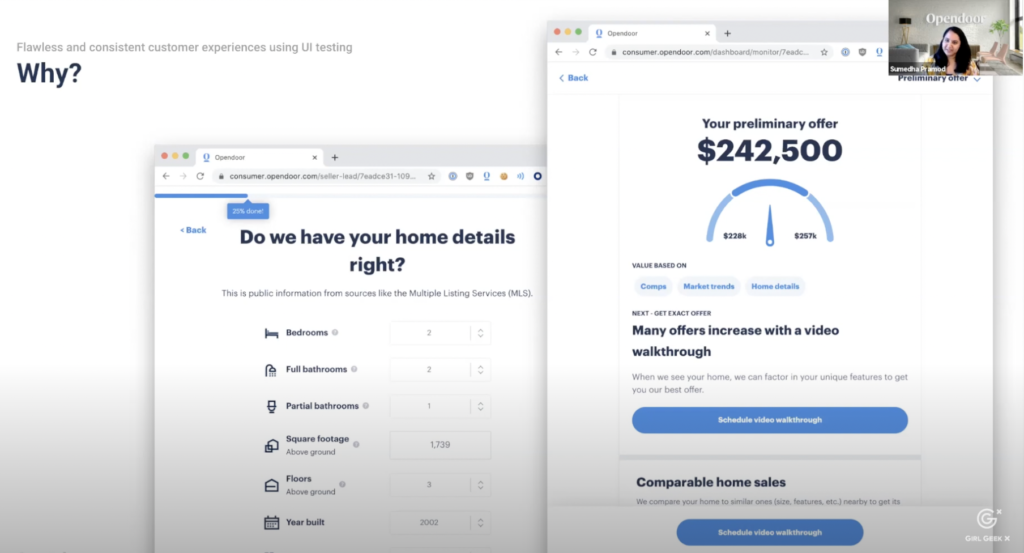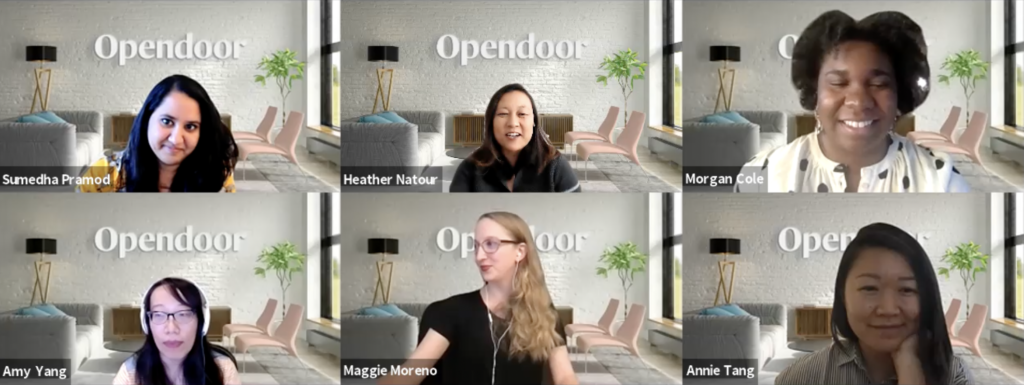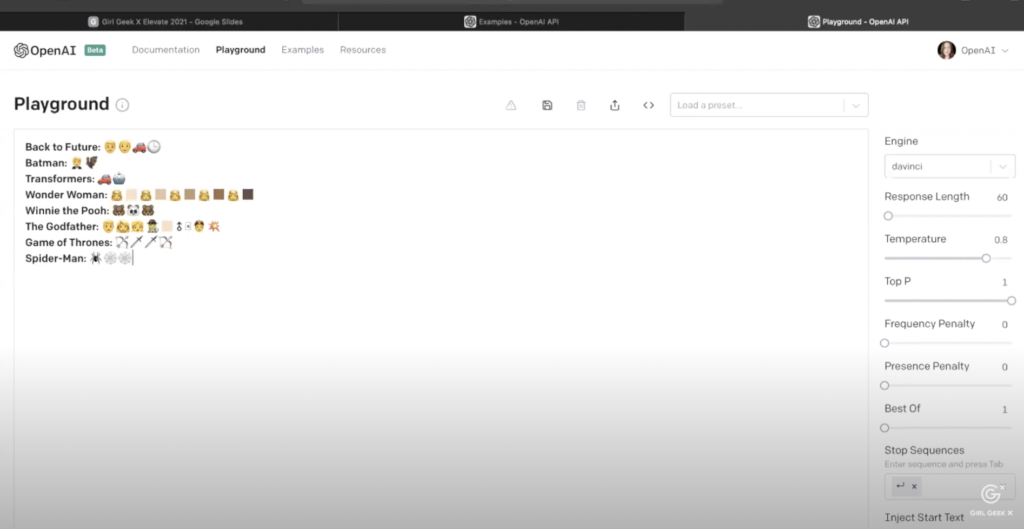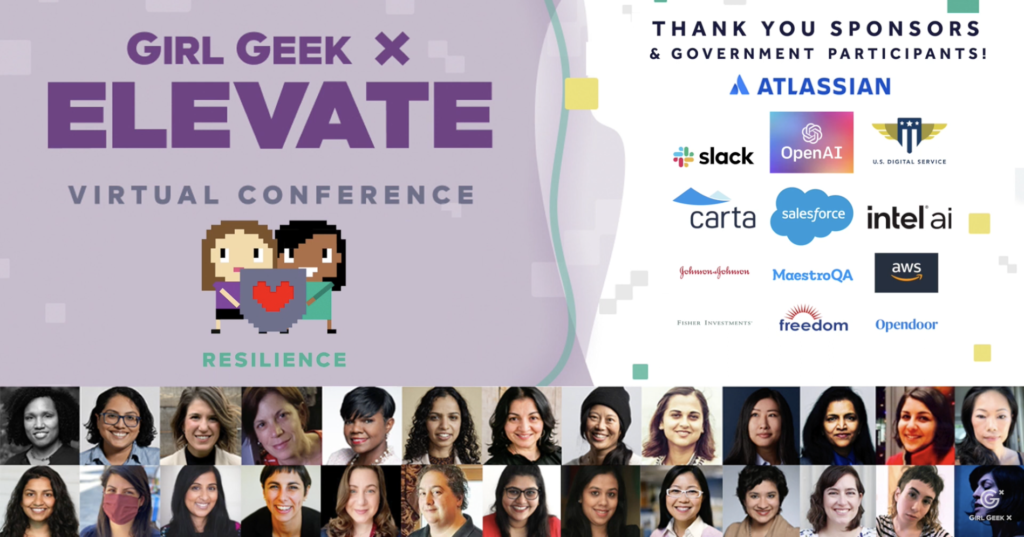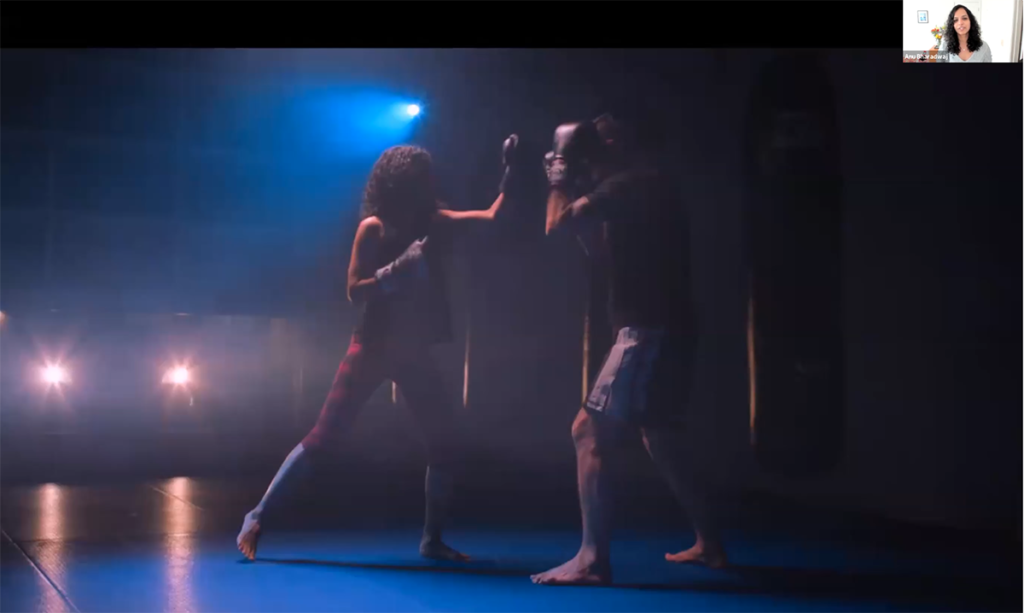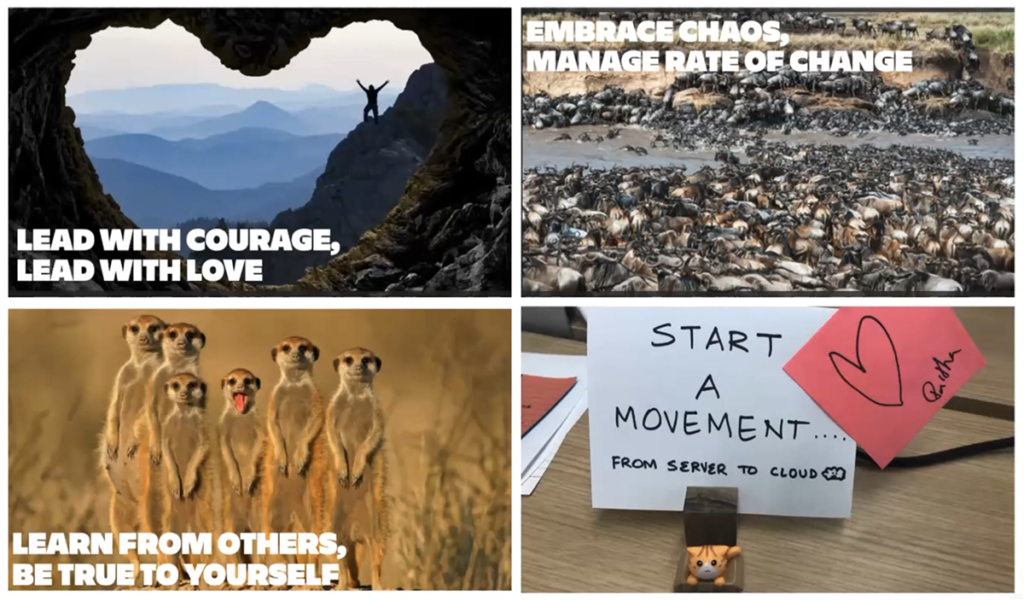Like what you see here? Our mission-aligned Girl Geek X partners are hiring!
- Check out open jobs at our trusted partner companies.
- Watch all ELEVATE 2023 conference video replays!
- Does your company want to sponsor a Girl Geek Dinner or Career Fair? Talk to us!

Angie Chang: We’re so excited to hear where you’re dialing in from today. Hi, my name is Angie Chang and I’m the founder of Girl Geek X, formerly known as Bay Area Girl Geek Dinners. We’ve hosted over a decade of Girl Geek dinners in the San Francisco Bay Area, and over the last five years we’ve been doing ELEVATE Virtual Conferences and Career Fairs to create even more opportunities to give more women the mic on stage.
Angie Chang: Thank you for joining us for our third ever Girl Geek X ELEVATE Virtual Conference and Career Fair, where every quarter we’ve been gathering over a thousand women online for career and tech talks, networking annually on International Women’s Day and now quarterly in this curious economic environment we’re offering more opportunities to connect, recharge, learn, and prepare for job interviews for the future.
Angie Chang: This time we’ve added a new mentorship lounge to kick off in the morning. Thank you to the 40 mentors who volunteered to join us as experts on engineering, product, health tech, cybersecurity, AI and more. And I definitely recommend connecting with them on LinkedIn and staying in touch. We have today in Airmeet a participation leaderboard to encourage and reward you for visiting booths at noon Pacific Time, attending sessions, commenting, hitting the cute little emojis at the bottom where you say, “👏,” or, “❤️.”
Angie Chang: Being active in chat is good, scheduling meetings in this Airmeet software. These are all things that you can do. And the top three participants will get a Girl Geek X swag bag of cool stuff, which includes socks and totes and stickers. Please help us drive participation, get up in that leaderboard rank, and I’ll be contacting you to send you your swag bag.
Angie Chang: When this pandemic locked us down and education was disrupted, the Girl Geek X community began volunteering at a local East Oakland school in partnership with a nonprofit called the Oakland Education Fund. If you happen to be in the area, we encourage you to join us in Oakland to volunteer or host us in the San Francisco bay area at your tech company for a field trip for public school students. This is our third year partnering with this nonprofit to bring our professional network of women and allies into the Oakland schools, to provide a helping hand for educators, and to introduce to the students role models.
Angie Chang: We took the entire senior class to Amazon Web Services last year, and hope to do more field trips this year to tech companies to inspire students to work in the field and get their degree or study engineering or something that can lead to a career in tech.
Angie Chang: We love our sponsors. Their support keeps us hosting Girl Geek X events like Girl Geek Dinners and this annual Elevate virtual conference and career fair, and all the opportunities we have to pass the microphone to Girl Geeks and women on stage.
Angie Chang: Thank you to Bentley Systems and to The New Club for all of your support and enthusiasm for women in tech. We can’t wait for your recruiters to meet our attendees at the virtual career fair starting at noon Pacific Time today until 1:00 PM Pacific Time.
Angie Chang: Given the economic climate, you probably know someone who’s looking for a job and I encourage you to take a look at all the featured job listings at girlgeek.io/jobs. Those have been updated as of last night. Those are fresh jobs. Please check them out and there’s a lot of remote and hybrid roles there. On to Sukrutha.
Sukrutha Bhadouria: Hi. Thanks, Angie. Hi everyone. I’m Sukrutha. A little bit about the Girl Geek X history I want to touch upon. The Girl Geek X organization started off over 10 years ago, and at the time it was just meant to bring women together at various companies and just connect with each other so you realize you’re not alone in whatever challenges you’re hitting, right?
Sukrutha Bhadouria: Because we’re always hitting challenges in our day-to-day work life. Either we’re looking to grow in our jobs sequentially or laterally, and we just need more and more people to talk to and talk about whatever we are going through. That served us really well as we started to build this community of amazing people who are working in various roles in tech. That went on from events every single week at different companies in the Bay Area to being booked up a whole year in advance.
Sukrutha Bhadouria: We would be booked up so far in advance in these in-person events that sometimes the people we had locked down the event with at that said company had already moved on and changed jobs. And that’s how far ahead we were scheduled for. We then moved on to virtual conferences and podcasts and now career fairs, and this wonderful mentorship session that happened earlier today.
Sukrutha Bhadouria: We’re really hopeful that as the economic situation continues to evolve, we continue to serve you accordingly. But one thing that has stayed consistent is us feeling the need to showcase amazing people who have varied experience levels and varied skill levels, shared their journey and shared their knowledge with all of you so that we can continue to grow together and lift as we claim.
Sukrutha Bhadouria: Today, we’ll be hearing from a diverse set of women working in tech, from executives to individual contributors. We love hearing from women just like you about your unique expertise, and of course not to mention the inspiring stories that come out of it. There’s also amazing, cool job titles that we get to learn about that we may or may not have known about. And of course, incredible passions and values.
Sukrutha Bhadouria: I’m sure that our speakers will inspire you to do exactly that and do that hard thing that you want to do, but you’re feeling a little bit afraid or stuck and that’s preventing you from doing it. But basically we want to help you think differently because that’s what we think is needed. We’ll be learning so much today and we encourage you to help us amplify and elevate the incredible takeaways that our speakers will be sharing. Please do share on your social media with #ElevateWomen.
Sukrutha Bhadouria: All of these talks that are happening today, not to worry if you have a meeting that clashes with it or something personal to take care of, they are all being recorded and will be put on our YouTube channel at Girl Geek X later once we’ve sort of sliced and diced it. You can also immediately hit replay in this platform after the session ends. So anytime, afternoon, evening, later this week, next week, you can watch and re-watch the sessions. I myself sometimes like to go back and make notes, especially when it’s a topic where I’m learning something new or it’s resonating or hitting differently with me.
Sukrutha Bhadouria: I do want to say though that many of our speakers today were speaker submissions. We are really happy to be giving a stage and a voice to people who might otherwise be a little bit nervous and afraid. We tend to have a lot of first time speakers. Do give them cheers and encouragement while the session is going on, and even on social media, like I said with #ElevateWomen.
Sukrutha Bhadouria: I want to continue to see applications coming through as we continue to have events like this. And the next one that we will have is December 6th and then March 8th, where we will continue to celebrate women together as we climb.
Sukrutha Bhadouria: We’re looking for sponsors always, always so that we can continue to showcase the opportunities that exist for women in tech to partner with us and to showcase their leaders and talent and recruit from each other because that’s the best when you can recruit people who you can continue to grow or really grow with.
Sukrutha Bhadouria: And that’s where we want to continue to have this space where we will create more role models in the world. I want to say one final thing though, that sometimes when things are getting hard at work or in life, it feels like the grass is greener on the other side, but truly it’s all just grass and the grass just gets greener wherever you water it.
Sukrutha Bhadouria: Make sure to nurture your passions and continue to spend time thinking about what is that one thing that you would do if you weren’t afraid? Just go for it. All right, without any more time spent on this, I want to bring up our keynote speaker on Introverted Leaders, and we want to know who else amongst you identifies as an introvert.
Sukrutha Bhadouria: I myself keep swinging between introvert and extrovert, so I don’t know if that makes me an ambivert, but do tell us in the polls. It’ll show us the results live, and so that’ll be nice to see how you’re feeling today. Feel free to write in the chat as well if you want to create a new name for what category you fall into and share with us your tips and tricks in the chat. All right, thank you so much. Back to you, Angie.
Angie Chang: Introducing Nicole. She is the COO at Lighthouse Labs, a tech education and training company, specializing in coding, data and cybersecurity. Nicole blends a strategic vision and operational expertise to scale outcomes in mission-driven companies. Her passion for pursuing solutions to societal issues at the intersection of science, technology and education have led her on a winding path through discovering a gene for night blindness during her PhD, to building an open and free global STEM community providing science content to over 2 million users in over 140 countries, and creating bridging programs in tech for women and youth from underrepresented communities. Nicole is a lifelong learner with a strong belief that there’s no limit to how many times you can ask yourself what do you want to be when you grow up. We’re excited to welcome our keynote speaker, Nicole.
Nicole Husain: Thank you very much, Angie, and thank you to girl geek for putting together this wonderful conference. I’ve certainly watched a lot of talks over the years and I’ve always admired the breadth of content, the explicit encouragement, especially what you said today about encouraging speakers of all backgrounds and experience to submit because sometimes people need a little nudge.
Nicole Husain: Put in the chat as the poll’s ongoing, what’s changing in there, but it looks like there’s a heavily introverted audience. Oh, it looks like I can’t share my screen with the poll. There we go. This is my first time presenting at Girl Geek. As I said, I’ve attended a lot of the sessions previously and I’m pretty excited to geek out with you on a topic that I’m passionate about. And yes, you heard that right, I’m an introvert and I described the next 30 minutes we have together as exciting.
Nicole Husain: Now, admittedly, it’s not the most introverted thing I do, but as I share my thoughts with you today, you’ll see why public speaking has had to become a natural part of my career growth, and that I’ve had to come up with different ways to nurture and bring out my strengths because I definitely voted I’m an introvert and I’m pretty far on the scale. I’m nowhere near an ambivert.
Nicole Husain: Over my career, I’ve attended many sessions on how to be more assertive, more confident, a harder negotiator, but I hardly ever heard from people on how to be a better quiet leader, a calmer and more thoughtful presence, and rarely from an introvert’s perspective. The poll that we put up was partly to vet our guests on the split of the audience. I did want to make sure that there was talking points and I was tailoring it to multiple people. But I realized it was also a bit of a trick question, because today’s talk is partly the one I needed much earlier in my career, but it’s really a talk for anyone interested in bringing out the best in everyone at work.
Nicole Husain: Even if you’re not an introvert yourself, you likely work with one or probably many. Most people know more introverts than they think, partly because a lot of them tend to pass as extroverted or feel that they need to be more extroverted. By the end of today’s session, I’m hoping to leave you with a few takeaways. One, introversion does not have to be a barrier to leadership.
Nicole Husain: Companies do need more introverted leaders just like you. Your big thoughts, your big ideas, companies need more of that. And I will leave you with some actionable steps on how to get yourself heard and maybe a little bit more visible for opportunities that you’re looking for. And don’t worry, none of my advice includes being more extroverted. You’ll get tips for introverts by an introvert.
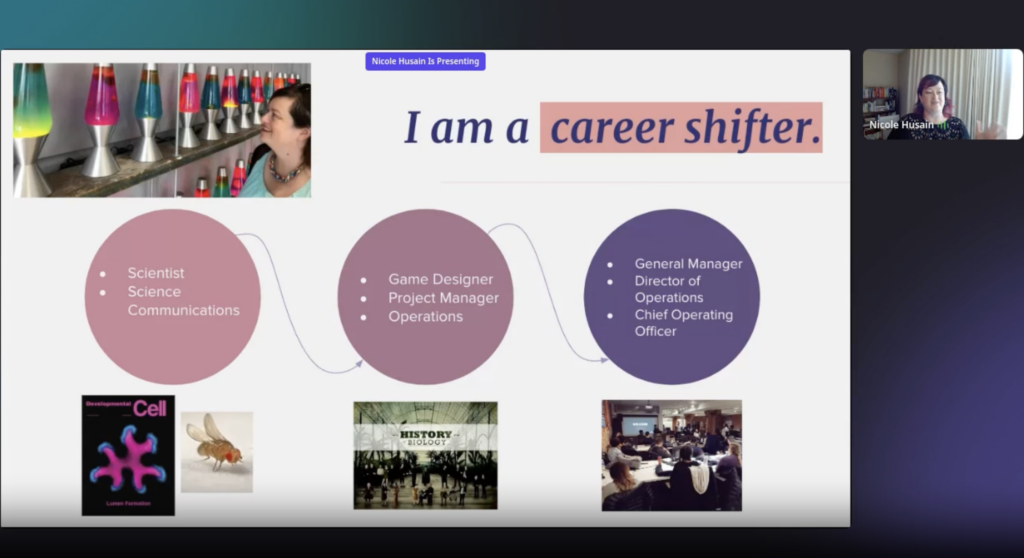
Nicole Husain: Let’s get started with who am I? My name is Nicole and I call myself a career shifter. And I partly call myself a career shifter because you can see the major parts of my career and really my path to tech was not linear, and I never really associated myself with the term career changer, because what I really felt I was doing was taking the skills in different parts of my experience and shifting them to different problems and different industries I am a scientist by training. I have a PhD in cell biology. I studied night blindness in fruit flies, and they were probably some of the best years of my life, because I really got to nerd out about a specific topic with like-minded people probably until the point that I realized that I underestimated how much public speaking was even in science.
Nicole Husain: People want to share. When you have great ideas, when you’re pushing the boundaries of research, you do need to get out there and share that information. And so that was kind of my first awakening to, oh, maybe I need to be a little bit better at the public speaking because I like doing it, but I’m not sure how. From there I made the very next logical step and became the first employee at an EdTech startup where I got to build educational biology games.
Nicole Husain: It was really a very neat intersection of my passion around science, technology, and my deep experience of video games, which is not something I thought would ever end up in a cover letter, but I spent a lot of time there. I spent many years there building games, taking on lots of different roles, and it was a really good transition for me to see both what I was good at, what I could do if there was no one else to do it, and then really what I found is I very much like the operational side of things, and that landed me to where I currently am today, which is Lighthouse Labs.
Nicole Husain: You can see even at Lighthouse, I’ve gone through a few different roles as we’ve grown. This slide is one I actually share internally when I’m doing onboarding for new teams or new people that have joined, because I think it’s important to show that career paths are not linear. I can go back now and tell a very nice story, but that’s not what it looked like in the transitions.
Nicole Husain: A lot of these roles and companies even didn’t exist in high school, which is traditionally where a lot of people have career conversations with guidance counselors on what do they want to be when they grow up. But the other thing that I share explicitly with people is that I am an introvert, and I find that I’ve ended up kind of being an unofficial advocate for introverted leadership, usually more one-on-one. Today I’m obviously choosing to share a little bit more broadly and I am explicit about my personality style because it is how I show up in a lot of rooms.
Nicole Husain: I often will explain to people I’m not shy, but I am quiet. If you’re in meetings with me, you might notice that maybe I don’t actually speak a lot all the time, sometimes I do. Often I do like to observe and I listen and that’s how I process the information and think about it, can I build my own mental model? I love thinking deeply about problems. I’d say that’s probably the thread that ties my career the most, is that each stage of my career, I had problems that I was very passionate about and really drove me in areas where maybe I didn’t have the skills or the experience to really grow in areas because I didn’t want to be held back by that.
Nicole Husain: You might be wondering, someone who’s had this very interesting career path, is an introvert is up here talking and sharing information. Why do I do this? I do this because of what I call my introvert origin story. This goes back to my undergrad days, so longer than I’ll want to admit. This happened at the end of a job application, I had applied to be a residents assistant, which is, if you’re not familiar with it, someone who on campuses at colleges and universities take care of a group of students. They might be new students, they might be second or third year students, but you’re their point of contact. And you’re someone who helps them if there’s problems, but you also create a good environment, you create a good experience for the students you have.
Nicole Husain: It usually comes with perks, like reduced residence fees, which is alluring for anyone. I thought that it’d be a really great opportunity because I was very involved, but I found myself being very involved in different kinds of activities than say a lot of my peers. This was a pretty hard job to get because it came with perks, like discounts on residence fees. I think there were six or seven stages, lots of interviews. There was personality testing, there was a meeting with a psychologist. They were really doing their due diligence on making sure that the people brought into this role could handle it, because it wasn’t always fun pieces.
Nicole Husain: It ended with a very large networking session where they invited deans and faculty members to kind of give us an idea of what leadership would look like. At the end, after all that, I got the job, was super excited, but it came with these words. They were very surprised to have this conversation, and it’s a moment that’s very clear to me. What they told me was, “You can’t possibly be an introvert. We’ve designed our interview process to weed out people like you because introverts don’t make good leaders.”
Nicole Husain: I remember sitting there and saying, “First, what’s an introvert? I thought I was just kind of quiet and nerdy, and even if I am what you say I am, why is that a problem for this role? There are other people like me. This shouldn’t be so hard.”
Nicole Husain: One of the good things that came out of this was a book at the time called Please Understand Me, it goes really deep into some of the Myers-Briggs personality types. I find it was very eyeopening for me, not just about myself, but learning about others.
Nicole Husain: It was really kind of my north star that from this I realized that I never wanted to be held back or be underestimated by something like this, and that if I didn’t want to do something because I didn’t like it or it was too outside of my comfort zone, I wanted to be the one to make the choice.
Nicole Husain: A lot of the decisions I’ve made in my career, I can trace back to not wanting to be left out of an opportunity, and it’s led me to some really great places. Who is this talk for? This talk is for anyone who’s heard things like this. Typically, if you’ve heard it once, you’ve probably heard it a million times in your career. It normally shows up as, “You need to speak up more. You’re too quiet. You need to be more assertive. Why are you so serious? Are you okay? You didn’t say much.”
Nicole Husain: Now, on the other hand, if you’ve never heard those things, odds are you’ve probably said those things to somebody at some point. This talk is also for you, because it will give you some insights on what’s going inside some of the brains that you might be sharing this to. This talk today is really all encompassing. As I said, it goes very much for anyone who wants to be able to bring up the best in their teams. It may be for some of you who are looking for the nudge to do that next opportunity. Maybe you’ve tried, maybe you’re like, “Nicole, I tried, I stepped up, I tried to speak up more. I did all these things, but it didn’t work.”
Nicole Husain: I’m hoping I will give you a bunch of different tips and ideas on how you can either start something new or keep going if you’ve started to try.
Nicole Husain: If you’re one of the extroverts in the audience, there’s going to be some tips and tricks for you too. While I don’t want to get into all the details of personality and the tests and all those things, it’s probably a whole other talk, I’ll focus on some of the things that define introversion and extroversion in the workplace.
Nicole Husain: Typically you’ll find that introverts need to recharge in the quiet. They do a lot of thinking in order to share their words verbally. They typically really value one-on-one interactions and they often favor solo deep work. On the other side, extroverts, typically really energized around people. They often do their best thinking while they’re speaking out loud. They typically have large social networks and they really thrive in teams. And again, as we did that poll, this is really a spectrum.
Nicole Husain: Where you fall on that spectrum, you can also be right in the middle and a mix of both. If you’re not sure, one of the best examples I heard was from Simon Sinek. He’s written books like Start With Why, Leaders Eat Last, The Infinite Game. And he talks about how introverts wake up in the morning with a specific number of coins.
Nicole Husain: They may have five coins, and they have five coins to spend on people interactions that they’ll eventually need to recover from and get some more energy. Once they’re out of those five coins, that’s it. It may also sound, you may have heard from people when they say, “I’m done people-ing for the day.” Usually that means they’re out of coins.
Nicole Husain: The extroverts on the other hand typically wake up with no coins and they generate them as they go throughout the day. The more interactive they are with people, the more energy they get from people and meetings, they can end up with a day with a huge pile of coins depending on how many interactions they’ve had in the day. I find that a very good, if you’re trying to figure out where you are on the spectrum, somewhere in there was an analogy that really landed well for me. As much as I don’t think that introversion should be a barrier in the workplace, or opportunities, or for anything really, it can be for some reasons.
Nicole Husain: What I often hear over and over again is being introverted is holding people back in their career goals, and why. The reasons why people can be feeling like they’re being held back, expressing emotions can be really awkward for introverts. It’s not that they don’t have feelings, they often have very big feelings, but expressing them is hard.
Nicole Husain: Someone explained it to me as, “It feels like I’m going out in public without any pants. That’s how vulnerable I feel when I’m sharing my emotions.” Sometimes jumping into a conversation feels like an extreme sport, right? Think of a ping-pong game going on. It’s got a natural flow and there’s someone on the side just trying to decide when to throw the ball in, when can they join? It’s really hard sometimes to get a word in with a really nice flowing conversation.
Nicole Husain: Managing people can really drain you, and it’s not that introverts aren’t good people managers, they can be great people managers because they’re very focused, they think intently, but it does drain them and they do need energy, do need to regenerate some of their energy at some point.
Nicole Husain: Often you have to make big decisions in the moment and that can feel like a lot of pressure that you don’t enjoy. Typically public speaking terrifies you. Now, public speaking terrifies a lot of people, but I find there is a particular intersection between being introverted and a public speaker that I will talk about at some point as well.
Nicole Husain: Even if that’s all true, why am I insisting you should still push forward to be heard? Because leadership is not a one size fits all. There’s lots of definitions of leadership. It’s not usually related to titles. This is particularly one I like by Brene Brown, that a leader is anyone who takes on responsibility for finding the potential in people and processes and has the courage to develop that potential. I think really that courage to develop the potential applies to everyone. Often that is what’s holding people back. There’s something in there about needing the courage to develop people, think about how to build the best team, and really depending on what research you believe and what people are feeling on the day, especially if they’re an ambivert, somewhere between 25 to 40% of people are introverts.
Nicole Husain: If you’re thinking about your teams and your companies, there’s probably more people that are introverted that you think. If your job as a leader to really bring out the best in everyone, then you really should be thinking about all the different ways you can do that, whether you’re introverted or extroverted.
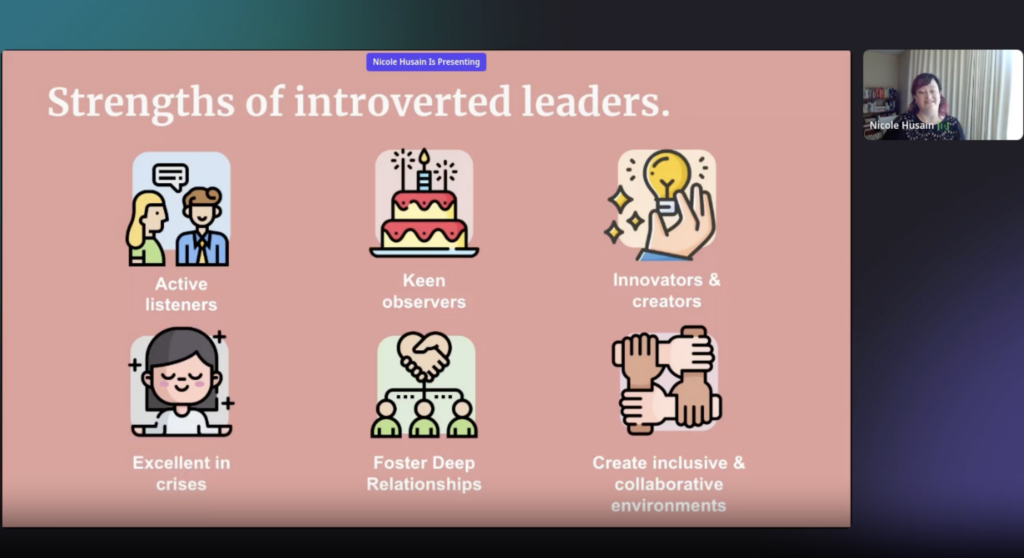
Nicole Husain: I’m going to go through my kind of top six strengths for why I think introverted leaders are awesome. One, they are great active listeners, and if you’ve had a really deep conversation with one, you know. They really, really listen. They’re not just waiting to say the next thing to bring up their next point. They’re actively listening to you and will have some thoughts for you. Maybe not right away, but they will have some good thoughts for you.
Nicole Husain: They’re typically keen observers, right? They sit back, they watch, they process, they often see things that other people can’t because they’re constantly building that mental model. They notice the details. They’re typically even great gift givers. How they celebrate their teams, they will think about something very personal, like their very specific coffee drink that comes from a place that’s very hard for them to get to. Small things like that, that really show that they care.
Nicole Husain: They tend to be great innovators and creative folks. They think about things differently. They don’t always get the chance to bring that out, but they can think very deeply about problems, solutions. There’s lots of examples of history of scientists being great innovators, creators, same in tech.
Nicole Husain: Introverts can be very excellent in a crisis. They tend to be very calm. They love problem solving. They can often separate, expressing a lot of emotion or not expressing a lot of emotion is a big strength in a crisis. How are they thinking through the problems and the processes without worrying everyone else? There is very much a calm that people look to when you’re in a crisis.
Nicole Husain: They’re really good at fostering deep relationships. I tend to say they’re really great networkers. Their networking doesn’t look like the extroverts in the room, they’re not necessarily in a large group of people, but they’re very excellent in fostering those one-on-one relationships.
Nicole Husain: They typically go deep and they typically have excellent networks. I also find they create really great inclusive and collaborative environments. They’re more likely to have different ways of doing brainstorming in a team, different ways of people being able to share their voices because they’ve been there and they know how hard it is when you have a different style of communication or learning that they really like to change up what that environment is when they get a chance.
Nicole Husain: These are great strengths and my hypothesis on why we still don’t have as many introverted leaders looks a little something like this. If I think about myself, if I think about many people that I talk to, we have a lot of thoughts, like a lot, sometimes overwhelming, and sometimes if you get an introvert talking about something very specific that they’ve thought a lot about, you probably even can’t get them to stop talking.
Nicole Husain: They’ll write a lot of the stuff of that down. They’ll process it even more. But what they actually say in the moment, especially in workplaces that tend to be wired for fast and speed and decision-making, what you often hear in that moment is such a subset of what they’re thinking or writing down.
Nicole Husain: When I’m talking to people, and lots of folks will ask me advice over my careers, “What do you do?” I typically focus on this idea because it really is about how do you take all those things that you’re thinking and figure out how to share them. I’m not saying be more extroverted. What I’m saying is be creative in how you share information.
Nicole Husain: I’m going to focus on some very tangible areas for where I think you can focus your control and sharing more of those thoughts. How do you speak up more? I’m going to focus on meetings first because those are one of the things you can control. You can’t often control the larger culture or environment of your company, maybe your team environment is different, but there are a lot of things you can do to help yourself, not even on the fact that you’re an introvert, more that it’s good and better for people in teams to do this.
Nicole Husain: I like to focus on being prepared. A lot of introverts bring confidence from being prepared, having had the chance to think about things before going into a meeting where they might need to share an opinion.
Nicole Husain: My first advice is always ask for an agenda. If you’re already having an agenda and it’s listed out, great, the next step is, is there anything to pre-read? Can you read anything in advance?
Nicole Husain: Even if your company doesn’t have it or your team doesn’t have it, this is a subtle way for you to ask for something differently just by showing interest. You don’t have to call out that you’re an introvert, you just want to prepare, is there anything I can prepare for next week? If your teams or environments don’t have a habit of sending things in advance to read because it is work on people to put that together, if you get a chance, you can share some of your stuff. You can lead by example. Or if you can convince someone to share what they’re going to review in a meeting, make sure you write comments on it, follow up with it.
Nicole Husain: Most people, if they’ve started sharing information in advance and no one uses it, they stop doing it because it is extra work. But I find that can set people up for success and it’s just good for teams in general. Coming into meetings better prepared to have conversations, good for everybody.
Nicole Husain: My other strategy that I recommend people do is, go first. Sometimes that sounds like the opposite of what you might want to do, but if you struggle with getting a word in edgewise once the conversation has really taken off, going first eliminates that. It does mean that if you have information in advance, you can come with that in, or you can listen to particular parts of the conversation and focus on how you want to start. That can be really effective for people because it takes the pressure off of needing to force their way into conversations.
Nicole Husain: The complete opposite suggestion from that is actually going last. What I find is naturally introverts are very good processors. Sometimes the strength comes from not all the individual conversations and ideas, but going at the end, summarizing what you’ve heard, and then maybe even adding in some of your insights. That [inaudible] can be a really great strength in a room where there’s a lot of people who are in the moment.
Nicole Husain: Then really my favorite one, because I don’t think there’s a time limit to when you can stop sharing information and thoughts that you have. One of the most common things I hear is, “I had the best idea, but it came up after the meeting was done.” There’s nowhere that says the meeting self-destructs, the topic self-destructs after it ends.
Nicole Husain: There’s endless opportunities to take whatever thought or idea you have and share it. I know it sounds simple as I’m saying it out loud, but there is something that feels like a barrier, where you feel like, oh, I’m sharing this after. I should have shared this during. I can promise you no one who’s gotten a piece of information after a meeting is upset about it. If anything, it just shows that someone is still thinking about a problem they’re working on.
Nicole Husain: If you have instant messaging like Slack or Teams, you can send a Slack message. “Hey, I was thinking about this from your meeting the other day and this was an idea I had, or here was a thought or a comment.” You can send an email, you can find someone for a coffee chat. It can be one-on-one. It doesn’t have to be written either depending on how you like it, but that is a really good way to make sure your thoughts are being heard.
Nicole Husain: If you do it enough, people will actually start to get used to it and you’ll find that people will actually come to you after the meeting. They may expect less and less of you in the meeting, especially if you’re sharing a lot of things outside of that. You may find you’ve slightly nudged and changed the culture of working just by how you’re showing your value in ways that are your strengths. These are my favorites for in a meeting.
Nicole Husain: Now, what about for ideas outside of meetings? Still the same. Focus on what you can control, and I like to talk about one-on-ones. Manager one-on-ones, you should be having them. If you’re not, this is a good starting point to have them because it’s a really great setting to have those conversations. If there isn’t an agenda yet, same advice applies. Set an agenda. It’s your one-on-one time, you at least setting or even contributing to the agenda, you’ll know right away that some of your talking points are already going to be on there.
Nicole Husain: You can send things in advance, right? I love it when people send, “Here’s what I’m thinking about. If you have a chance to review it before…” People know that if you send it to me in advance, odds are I’ll read through it and I’ll have some ideas. Or if you give it to me right in our one-on-ones, it’s a little less. I might give you some stuff, but the best stuff doesn’t often come right in the moment for me, especially if you’re sending me five or six pages of a strategy or an idea or a project that you want to run.
Nicole Husain: I also recommend people figure out how to do your casual coffee chats across the company. Things like Donut is an app both in Slack and Teams where it sets up groups of people and it automatically just matches you with somebody else. You can opt in, you can decide how frequently you want to do it. You can set settings on whether you want to meet only people inside your department, outside your department, but it takes away that hesitation of who should I meet and how should I get to meet people?
Nicole Husain: It’s great when you’re starting new in a company, but I find it’s never too late to add something like that because it really just normalizes socializing within the office space, and I find it’s a really good way to get to know people, to get to know their business, what they work on, how they solve problems. When you are seeing them in meetings and other areas, sometimes they’ll already have heard some of your ideas, or heard some of your thoughts, and they may even ask you, or they may even speak for you in some cases, right? “Hey, I was having this chat last week and we should talk about this because this was a good idea that you brought up.”
Nicole Husain: These are my core tips of how do you speak up more in a way that I think fits most introverts’ style and makes them comfortable without really just trying to barge your way and keep up with a really fast conversation that might be going on.
Nicole Husain: My other kind of secret tip, and maybe it’s not so secret, but it’s one that surprises people for the most, is like many things on the slide, I think introverts and extroverts make excellent pairs. For many reasons, and I usually encourage both, whether you’re an extrovert or an introvert, to find your opposite.
Nicole Husain: There’s a bonus if you’re on the same team solving the same problems, because what I find is you get a firsthand view of how someone very different from you solves the same problem, how they go after it. There’s lots to be learned by watching on how other people will approach problem solving. I’m not saying take what works for them, but think about how they’re doing things and what you could implement in your process.
Nicole Husain: The coaching I’ll give for both people is what are the areas you need to work on and practice that with each other. Just as much as an extrovert might need to give an introvert more space, often people find introverts, because they make such great listeners, they’re really great brainstorming partners for extroverts. Extroverts typically need… Don’t need, but they typically do some of their best thinking by talking it out loud. I find someone who loves to listen, it’s kind of magic when they work together because there’s no pressure for the introvert to come up with answers or things on the moment. Their role, and it’s a very important role, is to listen, process, ask questions, nurture ideas.
Nicole Husain: I find anytime even I’m in a situation like that, I also get very inspired by the way someone’s brain will think and how they’re trying to brainstorm and solve problems. It leaves me with things to think about for days. I find it just a really good pairing, and especially if you find people who are at the same growth level. I’ve done little competitions with teams where they can both work on kind of the opposite, who needs to speak up more in a meeting, who needs to wait more time before they speak up? It’s a good way to make things fun that can feel very uncomfortable at the time or something that you really have to work hard at being. That’s my other things are better in pairs. It’s really what I feel about introverts and extroverts and how they work together.
Nicole Husain: Maybe you’ve been listening through all of this and you’re like, great, I have some better ideas of how maybe other people on my team are. I’m not really introverted myself, but you’ve given me some things to think about, and what should I do? What should I take away if I’m an extrovert and I should be thinking about how I run meetings, or am I making the most inclusive areas?
Nicole Husain: I usually give people a little rundown of a checklist, and I say extroverts, but it applies the other way. I also have to watch my style because I can be too introverted. I can lean too much to being async and written, and that doesn’t work for everyone on my team. Normally the rundown I’ll have people think about is ask yourself, who are the loudest voices in the room? What percent of a discussion do they take up?
Nicole Husain: There’s lots of apps now on transcription. They’ll actually break down the percentage for you of who’s speaking when. Sometimes it’s a nice piece of data to see. You may have an idea in your head, but actually seeing it can be very helpful.
Nicole Husain: It’s helpful to think about why are they the loudest voices in the room? Sometimes it’s because they’re the most senior. I know teams who have made rules that the most senior person speaks last to be able to give the opportunity for everyone else to speak up without feeling influenced by their opinion.
Nicole Husain: I also ask people to think about how often is real time communication the default? By no means am I saying change it up, because I think there’s a lot of value in having those conversations and connection, but there’s a lot of things you can wrap around that that makes it easier. It really is not one size fits all.
Nicole Husain: If you’re doing a brainstorming session, you can have a group of people who are energized brainstorming together, and then you can have three or four people who get the same amount of time by themselves to do the brainstorming before you bring everyone back to a group. There’s a lot of different ways that you can wrap things around, so that’s not the only way of communicating.
Nicole Husain: All right, now for the last part of this, that gets into public speaking. Because I wouldn’t address all the pieces if I didn’t talk about public speaking. Being introverted does not preclude you from being a great public speaker. You might even learn to enjoy it, but for a lot of people it is a long path. The further you get on any sort of leadership track or if you’re a people manager, the more you get further in your career, it calls for an ability to work well with people, communicate with stakeholders, often participate in lead meetings and especially public speaking.
Nicole Husain: For me, I actually define public speaking very broadly. It can be everything from leading a meeting, running an all-hands meeting. For some people they’ll describe it as sending a message, an all staff email, or even a general Slack that feels like public speaking to people, even if it’s not all verbal. I have some ideas on this, but they’re very broad, and this is where I very much ask you to leverage your introspection for yourself.
Nicole Husain: My first one is always about experimenting with different approaches and make it fun. And whatever fun means to you, people have lots of different ideas of how to make uncomfortable things fun. Traditionally, people have been going to things like Toastmasters. There is Ultraspeaking, which is cohort-based learning that I’ve been watching that’s doing some really great work in that. Improv, standup is where a lot of people have kind of practiced. It really gives you practice at thinking on your feet and at least being comfortable thinking on your feet, which can be part of what people are afraid of.
Nicole Husain: Finding accountability partner, finding someone that you can push and share your small wins with. I talked about pairing introverts and extroverts. I think that’s very key. Then being very strategic on where and how you work.
Nicole Husain: Small companies typically will have less people, smaller teams. You can find that in a big company too, but I think that’s very key on choosing where you choose and where you want to grow. I use public speaking as an advanced version of going first. I sometimes will have a hard time with small talk and breaking into groups, but when I lead go first and give a talk somewhere, I automatically have all my small talk speaking points. I can ask people what they thought. People often come up to me for feedback. It’s a very great motivator for going first.
Nicole Husain: Then really it comes down to, as I mentioned, leveraging the introspection for your own growth. Doing anything new, introvert, extrovert, doesn’t matter, anytime you’re trying to learn something new, it’s going to be uncomfortable. I find there’s three keys to this, is understand why this is important for you. If it’s not important to you, don’t do it. There’s nothing saying you have to do this. For me, it was about not wanting to be held back.
Nicole Husain: I also say practice makes better. You’re never trying to be perfect at this. It’s never going to be perfect. But the more you do it, and if you start with small wins, really being able to stack your wins, whatever public speaking looks like to you, and celebrating your wins is very key. Finding your comfort in the uncomfortableness of doing something new and knowing why you do it is often the secret.
Angie Chang: Thank you, Nicole. Sorry, we’re at time.
Nicole Husain: Yeah, I was just going to say thank everyone for that.
Angie Chang: Thank you. Thank you so much. Everyone’s really chattering and wanting to connect on LinkedIn, so please look at the chat and we’ll see you in the next session.
Nicole Husain: Excellent. Thank you so much.
Angie Chang: Thanks.
Like what you see here? Our mission-aligned Girl Geek X partners are hiring!
- Check out open jobs at our trusted partner companies.
- Watch all ELEVATE 2023 conference video replays!
- Does your company want to sponsor a Girl Geek Dinner or Career Fair? Talk to us!


